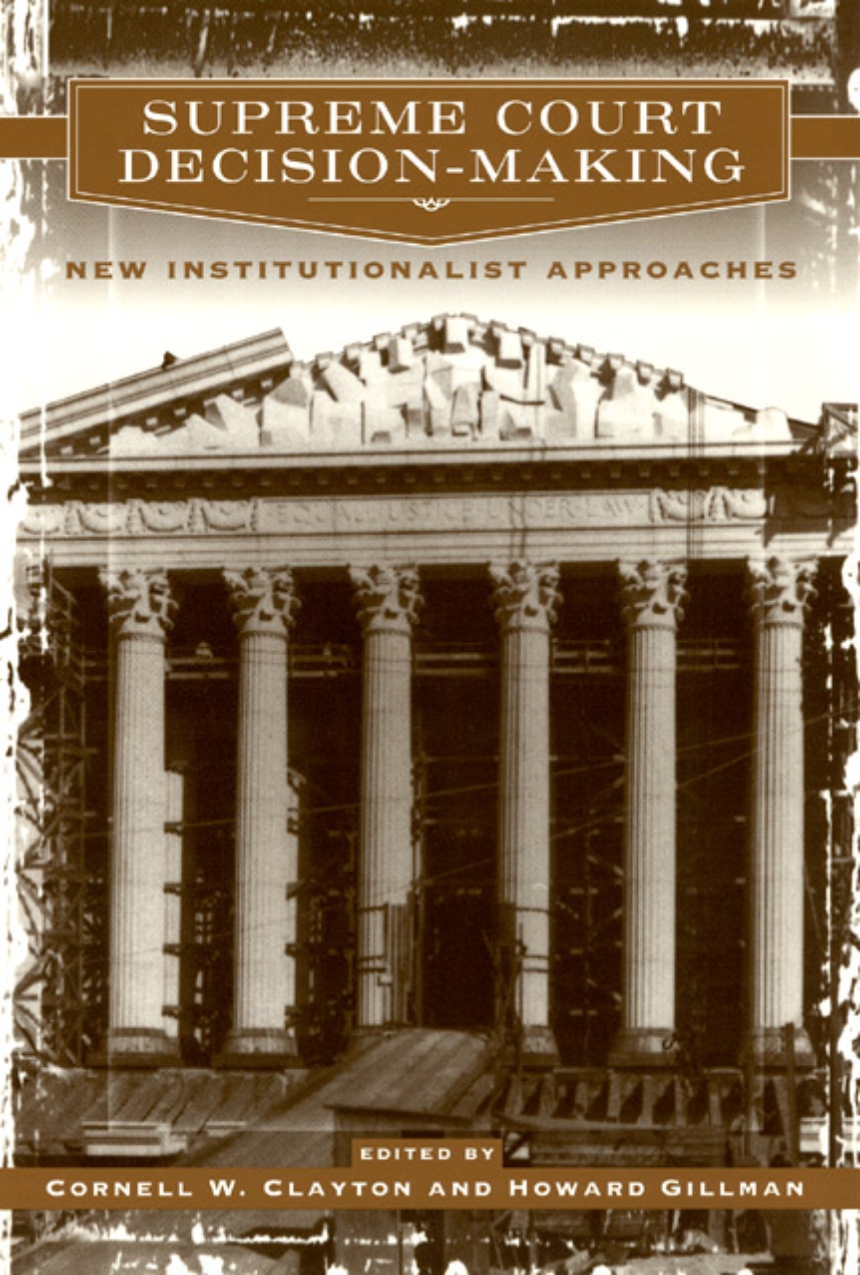Supreme Court Decision-Making
New Institutionalist Approaches
What influences decisions of the U.S. Supreme Court? For decades social scientists focused on the ideology of individual justices. Supreme Court Decision Making moves beyond this focus by exploring how justices are influenced by the distinctive features of courts as institutions and their place in the political system.
Drawing on interpretive-historical institutionalism as well as rational choice theory, a group of leading scholars consider such factors as the influence of jurisprudence, the unique characteristics of supreme courts, the dynamics of coalition building, and the effects of social movements. The volume’s distinguished contributors and broad range make it essential reading for those interested either in the Supreme Court or the nature of institutional politics.
Original essays contributed by Lawrence Baum, Paul Brace, Elizabeth Bussiere, Cornell Clayton, Sue Davis, Charles Epp, Lee Epstein, Howard Gillman, Melinda Gann Hall, Ronald Kahn, Jack Knight, Forrest Maltzman, David O’Brien, Jeffrey Segal, Charles Sheldon, James Spriggs II, and Paul Wahlbeck.
Drawing on interpretive-historical institutionalism as well as rational choice theory, a group of leading scholars consider such factors as the influence of jurisprudence, the unique characteristics of supreme courts, the dynamics of coalition building, and the effects of social movements. The volume’s distinguished contributors and broad range make it essential reading for those interested either in the Supreme Court or the nature of institutional politics.
Original essays contributed by Lawrence Baum, Paul Brace, Elizabeth Bussiere, Cornell Clayton, Sue Davis, Charles Epp, Lee Epstein, Howard Gillman, Melinda Gann Hall, Ronald Kahn, Jack Knight, Forrest Maltzman, David O’Brien, Jeffrey Segal, Charles Sheldon, James Spriggs II, and Paul Wahlbeck.
358 pages | 4 line drawings, 20 tables | 6 x 9 | © 1998
Law and Legal Studies: Law and Society, The Constitution and the Courts
Table of Contents
List of Figures and Tables
Acknowledgments
Introduction
Beyond Judicial Attitudes: Institutional Approaches to Supreme Court Decision-Making
Howard Gillman and Cornell W. Clayton
Part One: Conceptualizing the Supreme Court as an Institution
1. The Supreme Court and Political Jurisprudence: New and Old Institutionalisms
Cornell W. Clayton
2. Strategy and Judicial Choice: New Institutionalist Approaches to Supreme Court Decision-Making
Forrest Maltzman, James F. Spriggs II, and Paul J. Wahlbeck
3. The Court as an Idea, Not a Building (or a Game): Interpretive Institutionalism and the Analysis of Supreme Court Decision-Making
Howard Gillman
Part Two: Legal Norms and the Internal Structure of Supreme Court Decision-Making
4. Institutional Norms and Supreme Court Opinions: On Reconsidering the Rise of Individual Opinions
David M. O’Brien
5. The Incidence and Structure of Dissensus on a State Supreme Court
Charles H. Sheldon
6. The Chief Justice and Judicial Decision-Making: The Institutional Basis for Leadership on the Supreme Court
Sue Davis
7. The Supreme Court and the Development of the Welfare State: Judicial Liberalism and the Problem of Welfare Rights
Elizabeth Bussiere
8. Institutional Norms and Supreme Court Decision-Making: The Rehnquist Court on Privacy and Religion
Ronald Kahn
Part Three: Extra-Judicial Influences on Supreme Court Decision-Making
9. Recruitment and the Motivations of Supreme Court Justices
Lawrence Baum
10. Mapping Out the Strategic Terrain: The Informational Role of Amici Curiae
Lee Epstein and Jack Knight
11. Supreme Court Deference to Congress: An Examination of the Marksist Model
Jeffrey A. Segal
12. External Pressure and the Supreme Court’s Agenda
Charles R. Epp
13. State Supreme Courts and Their Environments: Avenues to General Theories of Judicial Choice
Melinda Gann Hall and Paul Brace
References
Cases Cited
Contributors
Index
Acknowledgments
Introduction
Beyond Judicial Attitudes: Institutional Approaches to Supreme Court Decision-Making
Howard Gillman and Cornell W. Clayton
Part One: Conceptualizing the Supreme Court as an Institution
1. The Supreme Court and Political Jurisprudence: New and Old Institutionalisms
Cornell W. Clayton
2. Strategy and Judicial Choice: New Institutionalist Approaches to Supreme Court Decision-Making
Forrest Maltzman, James F. Spriggs II, and Paul J. Wahlbeck
3. The Court as an Idea, Not a Building (or a Game): Interpretive Institutionalism and the Analysis of Supreme Court Decision-Making
Howard Gillman
Part Two: Legal Norms and the Internal Structure of Supreme Court Decision-Making
4. Institutional Norms and Supreme Court Opinions: On Reconsidering the Rise of Individual Opinions
David M. O’Brien
5. The Incidence and Structure of Dissensus on a State Supreme Court
Charles H. Sheldon
6. The Chief Justice and Judicial Decision-Making: The Institutional Basis for Leadership on the Supreme Court
Sue Davis
7. The Supreme Court and the Development of the Welfare State: Judicial Liberalism and the Problem of Welfare Rights
Elizabeth Bussiere
8. Institutional Norms and Supreme Court Decision-Making: The Rehnquist Court on Privacy and Religion
Ronald Kahn
Part Three: Extra-Judicial Influences on Supreme Court Decision-Making
9. Recruitment and the Motivations of Supreme Court Justices
Lawrence Baum
10. Mapping Out the Strategic Terrain: The Informational Role of Amici Curiae
Lee Epstein and Jack Knight
11. Supreme Court Deference to Congress: An Examination of the Marksist Model
Jeffrey A. Segal
12. External Pressure and the Supreme Court’s Agenda
Charles R. Epp
13. State Supreme Courts and Their Environments: Avenues to General Theories of Judicial Choice
Melinda Gann Hall and Paul Brace
References
Cases Cited
Contributors
Index
